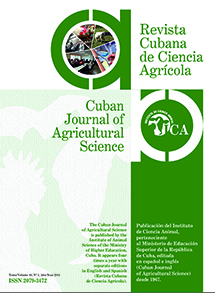Inclusion of different levels of Ricinus communis L leaf blade meal in whole diets for sheep
Contenido principal del artículo
Resumen
To evaluate different inclusion levels (0, 15, 30 and 45 %) of Ricinus communis leaf blade (LHRc) in whole sheep diets, four animals, with an initial weight of 27.37 ± 1.70 kg were housed in individual cages. Periods of 20 days were used. The first 15 days were used for diet adaptation, and the last five for measurement. A 4 x 4 Latin square design was applied, with Tukey test (P <0.05) for the multiple analysis of means, plus the linear regression analysis. Variables total food intake (TFI/kg DM), leaf intake (g DM Ricinus communis/kg LW), daily weight gain (DWG/kg),
food efficiency (FE/kg) and registration of poisoning signs, were studied. There was a statistical difference (P <0.05) in all variables. The best results were for 0% of Ricinus communis leaf blade (total feed intake 1,332 kg DM/day, daily weight gain 0.315 kg/day and food efficiency 0.254 kg), with respect to 45 % of LHRc (total food intake 0.881 kg DM/day, 12.2 g DM of Ricinus communis/ kg LW, daily weight gain 0.090 kg/day and food efficiency 0.096 kg). There was presence of diarrhea in this treatment, without compromising the life of animals. The rest of treatments shared statistical similarity. The inclusion of Ricinus communis leaf blade meal had a negative influence on dry matter intake of sheep, with a remarkable reduction in the 45% level, where there was also the presence of diarrhea, without causing deaths.
Key words: forage, arboreal, tropic, sheep
food efficiency (FE/kg) and registration of poisoning signs, were studied. There was a statistical difference (P <0.05) in all variables. The best results were for 0% of Ricinus communis leaf blade (total feed intake 1,332 kg DM/day, daily weight gain 0.315 kg/day and food efficiency 0.254 kg), with respect to 45 % of LHRc (total food intake 0.881 kg DM/day, 12.2 g DM of Ricinus communis/ kg LW, daily weight gain 0.090 kg/day and food efficiency 0.096 kg). There was presence of diarrhea in this treatment, without compromising the life of animals. The rest of treatments shared statistical similarity. The inclusion of Ricinus communis leaf blade meal had a negative influence on dry matter intake of sheep, with a remarkable reduction in the 45% level, where there was also the presence of diarrhea, without causing deaths.
Key words: forage, arboreal, tropic, sheep
Detalles del artículo
Cómo citar
Zamora, J., del Viento, A., Barrientos, L., & Palma, J. M. (2020). Inclusion of different levels of Ricinus communis L leaf blade meal in whole diets for sheep. Cuban Journal of Agricultural Science, 54(4). Recuperado a partir de https://mail.cjascience.com/index.php/CJAS/article/view/992
Sección
Ciencia Animal
Aquellos autores/as que tengan publicaciones con esta revista, aceptan los términos siguientes:
- Los autores/as conservarán sus derechos de autor y garantizarán a la revista el derecho de primera publicación de su obra, el cuál estará simultáneamente sujeto a la Licencia Creative Commons Attribution-NonCommercial 4.0 International (CC BY-NC 4.0) que permite a terceros compartir la obra siempre que se indique su autor y su primera publicación esta revista. Bajo esta licencia el autor será libre de:
- Compartir — copiar y redistribuir el material en cualquier medio o formato
- Adaptar — remezclar, transformar y crear a partir del material
- El licenciador no puede revocar estas libertades mientras cumpla con los términos de la licencia
Bajo las siguientes condiciones:
- Reconocimiento — Debe reconocer adecuadamente la autoría, proporcionar un enlace a la licencia e indicar si se han realizado cambios. Puede hacerlo de cualquier manera razonable, pero no de una manera que sugiera que tiene el apoyo del licenciador o lo recibe por el uso que hace.
- NoComercial — No puede utilizar el material para una finalidad comercial.
- No hay restricciones adicionales — No puede aplicar términos legales o medidas tecnológicas que legalmente restrinjan realizar aquello que la licencia permite.
- Los autores/as podrán adoptar otros acuerdos de licencia no exclusiva de distribución de la versión de la obra publicada (p. ej.: depositarla en un archivo telemático institucional o publicarla en un volumen monográfico) siempre que se indique la publicación inicial en esta revista.
- Se permite y recomienda a los autores/as difundir su obra a través de Internet (p. ej.: en archivos telemáticos institucionales o en su página web) antes y durante el proceso de envío, lo cual puede producir intercambios interesantes y aumentar las citas de la obra publicada. (Véase El efecto del acceso abierto).
